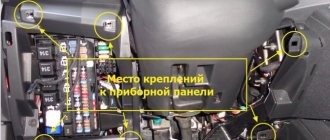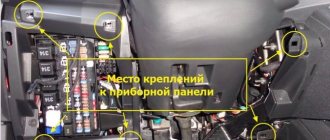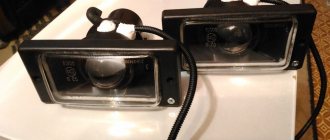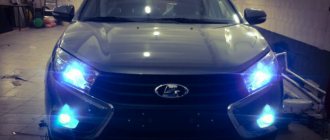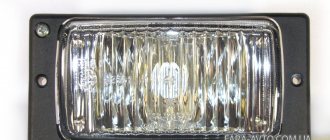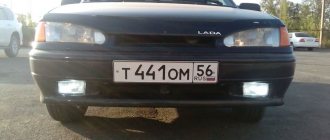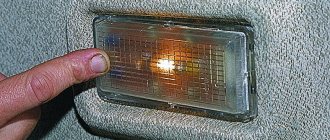The main thing is the color of the light flux. Next, the wire is connected to the stove backlight connector, and its second part goes to a separate PTF power button. They should be installed at a distance of no more than 40 cm from the edge of the side marker diffuser and no lower than 25 cm from the level of the road surface. Power to the relay, as a rule, is taken from the ignition switch, and the button is placed either in its standard place or chosen in a convenient location.
It's no secret that all modern vehicles are equipped with a special connector for mounting PTF, so the installation of fog lights is carried out strictly in them. Zotov A. How to connect fog lights (ptf), running lights through a relay But don’t forget about the car’s ground clearance. Connect the positive cable to the button input, extending it from the contact lock on the ignition switch. How does a light filter affect?
Only a fuse will save your vehicle from fire if a short circuit accidentally occurs in the circuit. On both headlights 1, such a contact is connected using a wire into a circuit, after which it is connected to ground or to metal parts of the car body by screwing it to the body with a bolt. We draw attention to the Rules, which state that PTFs should be turned on only after the side lights are turned on. The yellow spectrum, on the contrary, is not reflected from the water suspension, but penetrates it through and through, and although visibility is not ideal, it is significantly different from the driving conditions created by headlights. How to connect a button to fog lights or to a fan
PTF functionality
Any experienced car enthusiast, as well as an inexperienced one, is well aware of the role played by fog lights (FTL). In conditions of a white curtain, standard head lighting does not cope with its task of ensuring good visibility on the road, and all due to the fact that the fog is a suspension of water droplets, through which standard optics cannot penetrate. In addition, almost all of the light from such lanterns is reflected from the curtain. Thus, you get a whole white wall, which significantly complicates the view.
Anti-fog optics have their own emission spectrum that can penetrate such a wall. In addition, the luminous flux spreads horizontally and is directed downwards, which allows for good illumination of the road. Is it possible to install LEDs in fog lights? An interesting question that requires attention.
Connection and installation
I calculate the cross-section of the wires based on a current density of 3 amperes per square meter. mm., my fogs had three pairs of LEDs connected in parallel; they required 7 Volts at 2 Amperes of current. Thus, for connection I used a wire with a cross-section of 1.5 mm, that is, with a margin. Normally, the PTFs are connected with one wire, the ground goes along the body. For reasons of reliability, I ran both wires. The stabilizer itself in the engine compartment should be located away from the engine for better cooling (similar to the switch). The PTF itself, in accordance with the aforementioned UN document, should be located in width no further than 40 cm from the edges of the vehicle, the height should be from 25 to 80 cm above the surface, but not higher than the main light. It must turn on independently of other lighting devices; a control indicator for turning on is required. I connected it to the standard PTF connector, that is, all these requirements were met.
The main mistake of many drivers
With regard to PTF, most drivers make a grave mistake - using optics for purposes other than their intended purpose. In addition, things can simply reach the point of madness: drivers equip their vehicles with such optics in large quantities. It is not uncommon to find sedans with such lights (4 pieces or more) on their roofs at any time.
Meanwhile, the traffic rules clearly state that turning on the PTF is allowed only during the dark period of the day and in conditions of insufficient visibility (fog, smoke). Some drivers turn them on instead of low beams, which is also a gross violation of traffic rules.
Therefore, we should not forget that PTF is just additional optics, although some owners manage to convert fog lights to LEDs. Of course, it is impossible to completely abandon them, since under some circumstances they are very helpful. Their main advantage from a design point of view is their special reflector and diffuser. There is nothing like this in any other optics yet.
Paradoxically, it is the fog lamps that consume the most energy, producing a powerful luminous flux that is significantly brighter than low beams. Modern traffic regulations do not contain any instructions regarding the color range of the PTF luminous flux. Because of this, various manufacturers are conducting their own experiments.
Reflector calculation
The main result of a light device is a beam of light; accordingly, it is necessary to begin the development of PTF by determining the shape of the light beam that needs to be obtained. Since the task is to make a PTF, we turn to UNECE Rules No. 48, paragraph 6.3 “Front fog lamp”, subparagraph 6.3.5 “Geometric visibility” - the boundaries of the beam in the vertical plane are 5 degrees up and down, in the horizontal plane 45 degrees outwards and 10 degrees inward. It turns out that the standard fog light should produce a “sausage” with an aspect ratio of 10 to 55.
Having decided on the required shape of the light beam, you should decide on the light source. Modern Chinese industry offers a huge selection of LEDs, of different shapes, designed for different currents. The final luminous flux is measured in lumens, the efficiency of the LED is indicated in luminous efficiency Lumen/Watt, the average for cheap ultra-bright LEDs is about 200 lumens per Watt. In my opinion, the optimal ones are 3 W LEDs, which have a good light output with a small light-emitting surface. Why you shouldn’t use LEDs of higher power - because of the large area of the light-emitting crystal, which makes it much more difficult to obtain a light beam of the required shape. I ordered 50 3 W LEDs from China. When supplied at about 3.5 Volts, they consume a current of approximately 700 milliamps and glow as brightly as possible. At this current, the LEDs get quite hot. The current cannot be exceeded, and even a short surge in current is enough to burn out the LED, that is, a voltage stabilizer (ideally a current) is required. As the LED heats up, the current consumption increases, which leads to even greater heat generation and failure of the LED. In general, the service life of LEDs is often indicated in hours of 10 thousand, 50 thousand. The meaning of this figure is similar to the half-life of radioactive elements, that is, if it is said that the service life of an LED is 1000 hours, this means that after a thousand hours the LED will produce half as many lumens .
A little history
Returning to the topic of installing H11 LEDs in foglights, it’s worth rewinding a few decades ago and finding out where it all began. 1907 A laboratory in which one of the famous radio engineers, Guglielmo Marconi, spends his working time. It was he who noticed the glow effect of semiconductors, which was later called electroluminescence. Almost immediately, a note on this topic appeared in one of the scientific journals, but went unnoticed.
On the territory of the USSR, 20 years later, another scientist, Oleg Vladimirovich Losev, also discovered something similar. He conducted research on a silicon carbide crystal that glowed when current was passed through it. Subsequently, the effect received the name of a genius - Losev’s glow, and its author acquired a patent. However, the very nature of this glow was never discovered by the discoverer.
The answers came later
Long before drivers began installing H11 LEDs in the foglights of their cars, almost by the middle of the 20th century, the theory of pn junctions in relation to semiconductors was created. Based on this, in 1947 the first transistor was invented, which to this day has remained an unchanged element of radio engineering. The glow occurred when charged particles crossed a boundary consisting of two different semiconductor elements. And it is precisely the place where these two crystals come into contact that glows, which ultimately forms a kind of sandwich.
The whole difficulty lay in the production of semiconductors of the required structure. And this obstacle could not be overcome for a long time. Only since 1955 have research been successful. The first diode was produced by General Electric, although not everything is so simple here, since similar developments were also carried out in different countries of the world. But these are not yet the same H11 LEDs in the foglights of modern cars that are common today.
Features of lamp selection
The first samples of LEDs were expensive - the price of one such copy in 1968 was $200! The cost decreased gradually, and for some time no one could even imagine that such light sources would become the main competitor to incandescent lamps. And there was no talk about cars at all. Now, many car enthusiasts are faced with a difficult choice of which LED fog lights to buy for their car.
On the market you can find a wide range of automotive optics using diodes that differ in a number of parameters:
- form;
- dimensions;
- material of manufacture;
- shade of light flux.
There are also many manufacturers, but preference should be given only to trusted companies. As for the shape, on the modern market PTFs are presented in the form of a circle, rectangle, oval, square.
There is no useful function here other than aesthetics. Therefore, the choice depends only on the requirements and tastes of car enthusiasts.
Correct PTF
If desired, you can install LED PTFs yourself. Now there is a large selection of diode lamps on the market. Their prices and characteristics vary greatly. High-quality LED elements for PTF are produced by Osram, Wesem, Marimoto, Philips. They are distinguished by their high cost. But cheap lamps from little-known manufacturers are unlikely to meet existing requirements.
You must also pay attention to the correct installation. The easiest way to install LED light elements is in standard round-shaped PTFs.
Undeniable popularity
Despite the variety of PTFs, which are represented by LED, halogen, xenon products, the first one is at the peak of popularity. And all due to some undeniable advantages. And the main advantage is that LEDs emit much more light per watt when compared to standard incandescent bulbs. In addition, there is virtually no heating.
This allows you to consume less energy, and accordingly, the service life is significantly increased. There is an opinion that when using fog lights with LEDs you can save on fuel, even if not as significantly as you would like. In addition, the maximum luminous flux is generated very quickly, since there is no need for ignition, which some lamps lack. And if we compare it with a xenon analogue, then LEDs cannot blind drivers of oncoming cars.
Advantages of LED fog lights
The purpose of fog lights is to indicate the dimensions of the vehicle and provide the driver with adequate lighting in conditions of poor visibility. The fact is that in unfavorable weather, the rays of low or high beam are reflected from a suspension of water droplets and blind both the owner of the car and drivers moving towards the meeting.
Fog lights have a beam angle less than the reflection angle. Therefore, the person driving is not blinded by the reflected light of his own headlights. PTFs are located low above the road and improve illumination of the road surface thanks to a flat and wide beam. At the same time, yellow light lamps are more effective than blue and white ones, since yellow light has a longer wavelength and less scattering.
But standard optics do not always provide sufficient visibility for driving in bad weather. Many drivers are thinking about improving stock PTFs by installing LED lamps in them. They can be used as DRLs.
Fog lights with angel eyes are popular now. Not only are they an interesting design element, but they also provide high-quality lighting due to the lens used.
LEDs perform well as fog lighting and have the following advantages over halogen lamps:
- low power consumption;
- long service life;
- resistance to vibrations and shocks;
- less heating of the lamp and headlight glass;
- large selection of color temperatures;
- The LEDs light up and are ready for use almost instantly.
LEDs generate heat during operation and therefore require cooling. Violation of the thermal regime will lead to a loss of brightness and a reduction in lamp life. Therefore, diode lamps with high power (from 25 W) are equipped with a cooling system.
Design differences from halogen
Diode lamps are structurally different from halogen lamps in that the LED is a semiconductor device. It produces light when current passes. A halogen lamp consists of a sealed glass bulb filled with a gas mixture. A tungsten filament and electrodes are placed inside. When the brightness of the light flux is similar to that of a halogen, the diode lamp will have less power.
Another important plus
It is worth highlighting one more important advantage, which strongly distinguishes LEDs and brings them to the fore. Since they do not contain a filament, they are very resistant to various types of vibrations, which simply cannot be avoided when the car is moving.
Due to the wide range of colors, LEDs are an excellent option for giving your car an original appearance. A kind of tuning without significant outside intervention.
The LEDs themselves in foglights are characterized by their small size, which allows them to adapt to the design of any vehicle. But, unfortunately, there is one drawback, which will be discussed below.
Another important point
As mentioned above, the luminous flux can be of different shades:
- white;
- blue;
- red;
- yellow.
Here you should think not only about personal preferences, but also about other road users. For example, H3 LEDs in blue and white fog lights will blind oncoming drivers, which is not good for anyone, since not only personal safety depends on it. Therefore, it is better to purchase optics with a yellow tint.
Disadvantages of LEDs
The main disadvantage of LED lighting is its high cost. Another drawback is the insufficient brightness - only 700 lm, while the minimum indicator for lamps should be 1000 lm. Only in this case can the necessary visibility of the road surface be ensured in conditions of poor visibility. And as you can see, LED lamps do not satisfy the required condition, and therefore xenon is still in a leading position among other analogues. But overly bright light is not always good for the cause. And it is no coincidence that the use of such lamps is allowed with some reservations from the law.
You should be aware of these disadvantages before deciding to install LEDs in your foglights yourself.
Basic functions and operating principle of LED headlights
The main function of any fog lights is to ensure good visibility during fog, rain, snowfall and other “difficult” weather conditions. In addition, thanks to the wide beam of light, the roadside is much better illuminated, thereby making it easier to drive on winding roads. Headlights with the Corner function are quite common, in this case we have to talk about an even greater increase in the lighting angle. This function allows you to obtain a lighting angle in the range from -30° to +60°.
A similar effect is achieved thanks to the clear boundary of the upper edge of the beam and, of course, the low location of this lighting device . If you turn on the high beam while driving in fog, it will reflect from water droplets and blind the driver. But, as you know, the fog does not spread close to the ground, and there is still a gap before it, and it is in this strip that the light of these headlights should fall. This technique often saves people’s lives; it is useful to equip a car with them, but you should know something about the choice and features of operation.
Installation of PTF
There are no fundamental differences regarding the installation of PTF. You can only notice that it is easiest to install LEDs in standard round-shaped optics. If the headlights have an excellent shape, then you will need a lot of patience to find a suitable option that eliminates major alterations.
It is also worth taking into account that PTFs, regardless of design, are used together with the side lights of the car. But connecting them to the ignition using a separate button is highly not recommended.
Some cars do not have fog lights installed at all, which can often be found among domestic vehicles. Therefore, many drivers try to correct this situation by installing LEDs in their foglights on their own.
How to choose the right fog lights
Diagram for parallel connection of fog lights Electrical diagrams for installing fog lights differ only in the number of positive wires stretched to the lamp bases. Dashboard. But such a circuit in its pure form is not suitable for connecting fog lights. The headlights are connected only through a relay. We do not turn on the headlights, thereby saving expensive lamps and saving car energy. Now, when you press the power button, the minus is applied to the relay winding - the relay is activated and thereby closes contacts 30 and 87 of the relay and - our light bulbs light up! That's it! Where to start installation? Most often, yellow filters were installed on fog lights, because only they could give the light beam special characteristics. Otherwise, you will have to install the wiring yourself. They can be perfectly used to illuminate those areas that are not illuminated by standard optics.
We draw attention to the Rules, which state that PTFs should be turned on only after the side lights are turned on. Connection diagram for fog lights Let us immediately note that the simplest PTF connection diagram is to connect the fog lights from the battery through a switch. Connecting additional headlights via relay
More on the topic: Connect the light on the site
Hyundai Solaris
As mentioned above, it is easier to install LEDs in round standard optics, but for owners of a Hyundai Solaris, the situation is exactly the opposite. In this case, you have to dodge. But craftsmen found a good solution - installing LED fog lights on this car.
For this you will need:
- base H27 (2 pcs.);
- regular hexagonal ballpoint pen (2 pcs.);
- LED strip (1 meter).
You also cannot do without solder, soldering acid and the soldering iron itself. The entire procedure for installing LEDs in Solaris fog lights is simple, and can be described in a few words.
To begin with, you need to cut 6 pieces, each 50 mm long, from the common tape. Segments of about 65 mm in length are cut from ballpoint pens. A piece of tape should be glued to each edge, and then soldered together parallel to each other. The resulting structure is then attached to the base using glue and soldered to the base contacts. Before installing the resulting lamp in the headlight, it is better to check its functionality. If everything is in order, you can safely proceed to the direct installation of the LED PTF.
You can, of course, purchase ready-made options and not bother yourself with unnecessary work. However, it all depends on the family budget, since the cost of LED fog lights starts at about 5 thousand rubles. Therefore, for some drivers, DIY is the best option.
conclusions
What do we get in the end? It is precisely that LED PTFs do not provide any big advantages over standard halogen ones. Currently I'm driving with my neighbor on. In winter, when there is a lack of current, I simply turn off the headlights (at a traffic light, for example), if I see that there is not enough current to charge the battery. At the same time, I’m not afraid of breaking my fog lights in the next hole. Again, fashionable LED lighting devices attract unnecessary attention, and when undergoing maintenance, it is advisable to remove them, since a meticulous master may ask for a certificate. Again, the factory DRLs in the headlights look much more aesthetically pleasing. If you compare homemade ones with good factory copies, then there is no economic feasibility to assemble yourself, and ready-made LED PTFs for 3-4 thousand rubles apiece are worth the money. Another thing is that they ordered from China can be 2-3 times cheaper than if bought in Russian online stores. Thus, I closed this issue for myself, and I don’t plan to make any more additional lighting devices on diodes (PTF, DRL). The only thing is that I’ll probably assemble a 100 Watt chandelier.
LEDs have been around us for a long time. They are used in flashlights and mobile phones, but LED fog lights are also incredibly popular among car owners.
Public opinion
If anyone has doubts about the use of LEDs in PTFs, you can visit several forums on automotive topics.
By studying numerous reviews about LEDs in foglights, you can find out, for example, which lighting sources are best to purchase, since the market is flooded with various fakes that fail almost the next day.
At the same time, as often happens, there are supporters of a good alternative in the form of LEDs and their opponents. Many drivers note that the luminous flux is no worse than from xenon lamps. Others, on the contrary, do not see the difference, since, in their opinion, diodes do not shine much better than the same halogen bulbs.
But this happens all the time: some remain disappointed, while others see all the benefits. Perhaps it’s all about some subtleties of the headlight design or other factors. In any case, most drivers have already appreciated all the delights of LED lighting in foggy conditions. And many car enthusiasts were satisfied.
DIY LED HEADLIGHTS | LED FOG LIGHTS – handmade
High-power LED bulbs for fog lights with the correct cut-off line. They do not blind oncoming drivers. Manufacturing is not difficult, you don’t even need to break or disassemble the headlight. The whole idea is an LED light bulb with a special arrangement of LEDs. Cree LEDs of the XM-L2 T6 C3 series are used, with a light temperature of 5000K, that is, like daylight. For cooling, special heat pipes are used, such as those used in laptops for cooling, and passive radiators. To power the LEDs, I used a Chinese 5 amp driver, in which the current and voltage can be adjusted. The total consumption of one such LED lamp is about 14 watts, and the light intensity is almost the same as that of a 55-watt halogen lamp.
PART 1: LED HEADLIGHTS - the idea of creating LED fog lights | PART 1: LED FOG LIGHTS – the idea
The idea of creating LED fog lights that give the correct beam of light like factory lamps. Which can work in fog lamp mode and in daytime running lights mode. And which consume only 14 watts of electricity, which, although a little, saves gasoline! To be honest, similar lamps are already on the Chinese market, but their quality is highly questionable. I say this because I already had experience with Chinese lanterns and car bulbs. It is also not known how the Chinese light bulbs will shine, 99% is that they will not simply fall into the focus of the headlight. And the price of Chinese light bulbs is around $100. Therefore, I decided to make similar light bulbs myself, only from high-quality diodes and completely customized them to match my headlight, and set them to operate at 70% of their maximum power, so that they shine forever. Unlike the Chinese ones which operate at 110% of their capacity and burn out in just a couple of months((
PTF housing
The main requirement for an LED fog lamp housing is heat dissipation, since super-bright LEDs get very hot. I used radiators from processor coolers, and mounted the LEDs themselves on heat-conducting paste. The protective glass was made from plexiglass. You can use a jigsaw to cut a part of any desired shape from it. In this case, it is necessary to take into account that there are no protrusions on the glass itself on which dirt could linger. Of course, a mandatory requirement for the fog lamp housing is absolute tightness. In addition to the threat of contamination of the reflector, a leaky PTF will “sweat”, which will also reduce its effectiveness. I assembled the body using sealant. This is what a homemade PTF looks like disassembled:
To make homemade LED fog lights we will need:
- 2 LEDs 10W each;
- 2 aluminum radiators from disassembly;
- 2 rubber gaskets from plastic pipes DN50 mm;
- 2 lenses from an old projector;
- junction box;
- 2 LM317T chips;
- 2 resistors;
- terminal block;
- can;
- silicone sealant.
I tested it and selected the current = 0.8 A for each LED.
How this looks is shown in more detail in the video. Author of the article “DIY LED fog lights” Wop127
